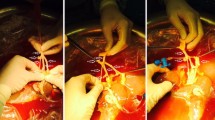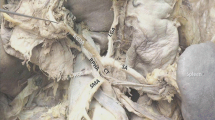Abstract
We report a rare variant in mesenteric arterial anatomy: replacement of the right hepatic and common hepatic arteries to the SMA in a patient treated for hepatocellular carcinoma. The potential clinical implications of this unusual variation of celiaco-mesenteric anatomy will be discussed.
Similar content being viewed by others
Avoid common mistakes on your manuscript.
Introduction
Anatomic variation of the celiaco-mesenteric vasculature is common and has been described over the last two centuries based on anatomic dissections, visceral arteriography and most recently on CT angiography. Recognition of variant anatomy is important for the surgeon in planning liver resection, liver transplantation, pancreatic, gall bladder, and gastric surgery. This anatomic variation not only includes the origination of arterial branches but also variation in the course of these branches with respect to the pancreas, portal vein, bile duct, and gallbladder as well as their course through the liver. We report an anatomic variation of the hepatic arterial supply to the liver not previously described and discuss its surgical implications.
Case presentation
A 49-year-old African American male with a history of hepatitis C and cirrhosis presented with a newly discovered 4-cm right-lobe hepatocellular carcinoma. The patient declined liver transplantation and was deemed a resection candidate. Prior to resection, chemoembolization with doxorubicin was performed in conjunction with right portal vein embolization to increase the volume of the left lobe of the liver. CT angiography followed by arteriography at the time of chemoembolization demonstrated an anatomic variation of the hepatic vasculature not previously described in extensive reviews of anatomic variations of the hepatic vasculature.
The celiac axis supplied the splenic and left gastric arteries (Fig. 1). The first branch of the superior mesenteric artery was the replaced right hepatic artery. Distal to this branch was the common hepatic artery giving rise to the left hepatic and gastroduodenal artery (Fig. 2). This variation was later demonstrated by catheter angiography at the time of chemoembolization. The replaced right hepatic artery was seen on CT to course posterior to the head of the pancreas and postero-lateral to the common bile duct and portal vein as most commonly described. The common hepatic artery was seen to course anterior to the head of the pancreas with the left hepatic artery entering the liver through the fissure of the ligamentum venosum (Fig. 3). These anatomic locations were verified in the operating room at the time of resection having been appreciated on preoperative imaging.
Discussion
The earliest evidence of normal and aberrant celiac trunk anatomy dates back to Haller’s text in 1756 [3]. One of the earliest attempts at classifying anatomic variants of the celiac axis and superior mesenteric arteries was by Lipshutz [6] in 1917. In 1955, a classic paper by Michels [7], described 10 variations of hepatic artery anatomy based on dissection of 200 cadavers (Table 1) with subsequent studies by Covey [2], Koops, [5], Hassan [4] and Chen [1] describing additional variations based on angiographic findings. Classic celiac axis anatomy was identified in 55% of cadavers in Michels’ cadaver study. Song’s study of celiac axis and common hepatic artery variations in 5002 patients based on CT and DSA [9] described classic celiac axis anatomy in 89% of patients and went on to analyze the course of the hepatic arteries relative to the head of the pancreas and the relationship of the hepatic artery to the portal vein in classic and variant anatomy. In Noussios’ [8] literature review of 20 publications and 19,013 cases of hepatic artery anatomy and variants, 81% of cases had classic celiac axis anatomy. 96% of cases could be classified as one of the ten variations described by Michels [7]. The most common variations of the hepatic artery are the replaced right hepatic artery to the SMA, and the replaced left hepatic artery to the left gastric artery reported to occur in approximately 11% and 10%, respectively, of the 200 dissections performed by Michels [7]. Although we were able to find one oblique reference to a right hepatic artery and a separate left hepatic artery replaced to the SMA [1], we could not find a report of a right hepatic artery and CHA replaced to the SMA as in our case.
The clinical implications of variant celiac anatomy can be significant. In our case, dissociation of the right and left hepatic arteries made resection of the right lobe of the liver easier. In the variant described, the length of the left hepatic artery could potentially make left lobe liver transplant easier. In our case, the right hepatic artery traveled posterior to the head of the pancreas and the common hepatic artery traveled anterior to the pancreatic head. If unrecognized pre-operatively, this variant could pose significant risk of injury to a hepatic artery during the course of pancreaticoduodenectomy or any surgical procedure adjacent to the head of the pancreas leading to intra-operative or postoperative hemorrhage, hepatic ischemia/necrosis, biliary duct ischemia or a leak at the biliary enteric anastomosis. Furthermore, foreknowledge of anatomy of the hepatic arteries and GDA is critical at the time of surgical implantation of hepatic artery pumps. These catheters are placed in the gastroduodenal artery at the junction of the gastroduodenal artery and proper hepatic artery. In this patient, placing the catheter in the gastroduodenal artery would have resulted in misperfusion.
Knowledge of the variant anatomy prior to chemoembolization will result in diminution of fluoroscopic time and radiation dose to the patient and operators.
Variation in anatomy of the celiaco-mesenteric vasculature is common. Multidetector CT scanning provides an opportunity for procedure planning both with respect to the presence of and anatomic course of anatomic variants. It is crucial for both the interventional radiologist and surgeon to appreciate both the variation in the classic anatomy and course of the anatomic variant.
References
Chen C et al (1998) Normal and variant anatomy of the hepatic arteries. Chin Med 61:17–23
Covey A et al (2002) Variant hepatic arterial anatomy revisited: digital subtraction angiography performed in 600 patients. Radiology 224(2):542–547
Haller A (1756) Icones anatomicae in quibus aliquae partes corporis humani delineatae proponuntur et arteriarum potissimum historia continetur. Vandenhoeck, Göttinger
Hassan O et al (2019) Aberrant arc between the common hepatic artery and a replaced right hepatic artery resulting in misperfusion in a patient with a hepatic arterial infusion pump. Surg Radiol Anat 41(3):355–359
Koops A et al (2004) Anatomic variations of the hepatic arteries in 604 selective celiac and superior mesenteric angiographies. Surg Radiol Anat 26(3):239–244
Lipshutz B (1917) A composite study of the coeliac axis artery. Ann Surg 65(2):159–169
Michels N (1966) Newer anatomy of the liver and its variant blood supply and collateral circulation. Am J of Surg 112(3):337–347
Noussios G et al (2017) The main anatomic variations of the hepatic artery and their importance. J Clin Med Res 9(4):248–252
Song S et al (2010) Celiac axis and common hepatic artery variations in 5002 patients: systemic analysis with spiral CT and DSA. Radiology 255(1):278–288
Author information
Authors and Affiliations
Contributions
LB: manuscript writer/editor interventional radiology attending. JN: manuscript writer/editor interventional radiology attending, participated in the interventional radiology portion of the case. GK: manuscript writer. SC: interventional radiology fellow and participated in chemoembolization. MSG: attending surgeon for hepatic resection.
Corresponding author
Ethics declarations
Conflict of interest
The authors have no conflicts of interest.
Additional information
Publisher's Note
Springer Nature remains neutral with regard to jurisdictional claims in published maps and institutional affiliations.
Rights and permissions
About this article
Cite this article
Bodner, L., Nosher, J., Khodorov, G. et al. Replaced right and common hepatic arteries with lienogastric trunk: a rare variant of celiaco-mesenteric anatomy. Surg Radiol Anat 42, 1475–1477 (2020). https://doi.org/10.1007/s00276-020-02505-8
Received:
Accepted:
Published:
Issue Date:
DOI: https://doi.org/10.1007/s00276-020-02505-8







